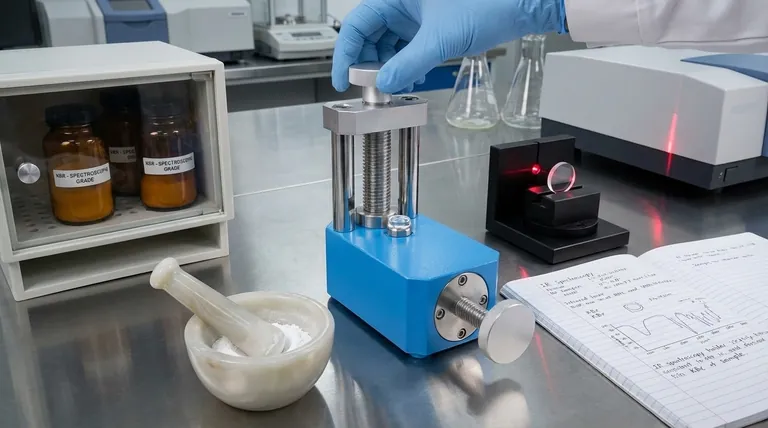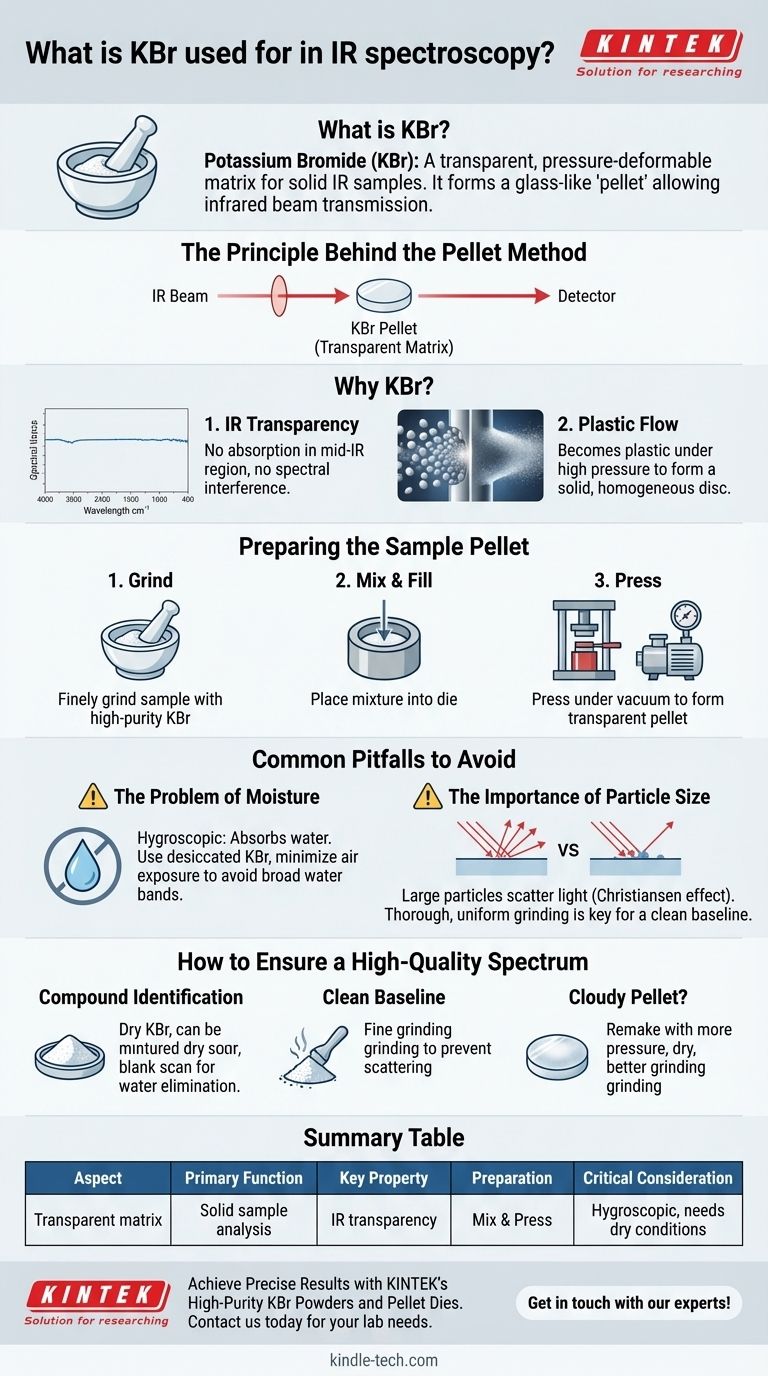在红外光谱学中,溴化钾(KBr)被用作透明基质,用于将固体样品固定在红外光束的路径中。它是一种碱金属卤化物,可以与粉末状样品混合并在高压下压制。这个过程形成一个薄的、玻璃状的圆盘或“压片”,它对红外辐射是透明的,这使得光谱仪能够测量样品的吸收光谱,而不会受到固定材料的干扰。
KBr的核心价值在于其独特的性能组合:它在广泛的频率范围内对红外光透明,并在压力下变得可塑,使其能够形成一个坚固、均匀的介质,有效地固定样品进行分析。
KBr压片法的原理
要理解为什么KBr是固体样品红外光谱学的行业标准,我们必须了解其特定的物理和光学特性。整个技术都建立在KBr作为红外光的“隐形窗口”的能力之上。
为什么KBr是理想的基质
溴化钾是一种离子盐。它的化学键在中红外区域(4000-400 cm⁻¹)不吸收红外辐射,而大多数有机和无机官能团都在此区域被识别。
这种红外透明性是最重要的特性。它确保仪器检测到的任何吸收峰都源于样品,而不是固定它的基质。
“塑性流动”现象
当承受巨大压力(通常是几吨)时,KBr的晶体结构会变形并流动。这就是参考文献中提到该材料变得“可塑”的意思。
单个KBr颗粒融合在一起,将细磨的样品颗粒捕获在一个坚固、均匀的圆盘中。最终的压片在物理上坚固且光学透明,就像一个小窗户一样。
制备样品压片
该过程包括将少量固体样品与大量高纯度KBr粉末精细研磨,通常在玛瑙研钵和研杵中进行。
然后将这种混合物放入压片模具中,并在真空下压制。真空有助于去除截留的空气和水分,这对于制造高质量、透明的压片至关重要。

常见需要避免的陷阱
虽然KBr压片法功能强大,但其成功取决于细致的技术。几个常见问题可能会损害最终光谱的质量。
水分问题
KBr是吸湿性的,这意味着它很容易从大气中吸收水分。水在红外光谱中具有非常强且宽的吸收带,这很容易掩盖样品的重要峰。
使用干燥的KBr并尽量减少样品在制备过程中暴露在空气中至关重要。最终压片的适当干燥也必不可少。
粒度的重要性
如果样品颗粒过大,它们会散射红外光而不是吸收它。这种现象被称为克里斯蒂安森效应(Christiansen effect),会导致基线扭曲、倾斜,并使光谱难以解释。
彻底均匀的研磨是最大限度减少散射并获得平坦、干净基线的关键。样品颗粒必须小于所用红外辐射的波长。
背景扫描的必要性
在运行样品之前,您必须使用纯KBr压片(“空白”)或空压片架进行背景扫描。
这允许仪器的软件减去大气中CO₂和水蒸气的任何吸收信号,以及KBr本身存在的任何散射效应或微量杂质。
如何确保高质量光谱
您的样品制备方法应由您的分析目标决定。细致的技术是可靠结果的基础。
- 如果您的主要重点是化合物鉴定: 确保您的KBr极其干燥,并使用纯KBr空白进行高质量背景扫描,以消除任何混淆的水峰。
- 如果您的主要重点是获得干净的基线: 将样品和KBr混合物研磨成极其细的粉末,以防止光散射。
- 如果您的压片看起来浑浊或不透明: 这表明压力不足、水分滞留或研磨不良。必须重新制作压片,以确保红外光束能够有效穿过它。
了解溴化钾的特性是掌握这种基本光谱技术的关键。
总结表:
| 方面 | KBr的关键作用 |
|---|---|
| 主要功能 | 用于固体样品分析的透明基质 |
| 关键特性 | 在中红外区域(4000-400 cm⁻¹)对红外光透明 |
| 制备 | 与样品混合并在高压下压制成压片 |
| 关键考虑因素 | 吸湿性;需要干燥条件以避免水分干扰 |
在您的红外光谱工作中实现精确可靠的结果。 样品制备的质量直接影响您的数据。KINTEK专注于高纯度KBr粉末和可靠的压片模具,专为实验室光谱学设计。我们的产品帮助您制作完美的压片,最大限度地减少水分和散射问题,以获得清晰、可解释的光谱。立即联系我们,讨论我们的实验室设备和耗材如何支持您的分析需求并提高您实验室的效率。 联系我们的专家!
图解指南




















